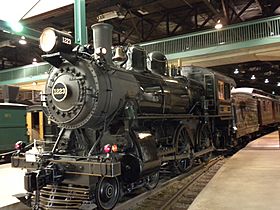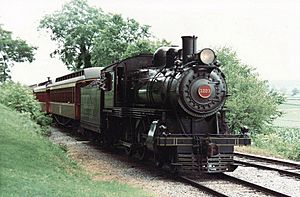Pennsylvania Railroad 1223 facts for kids
Quick facts for kids Pennsylvania Railroad 1223 |
|
 |
|
| PRR No. 1223 on static display at the Railroad Museum of Pennsylvania in March 2010 | |
| Power type | Steam |
|---|---|
| Builder | Altoona Works |
| Serial number | 1399 |
| Build date | November 8, 1905 |
| Configuration | 4-4-0 |
| Gauge | 4 ft 8 1⁄2 in (1,435 mm) |
| Driver diameter | 68 in (1,727 mm) |
| Length | 62 ft 7 in (19 m) |
| Weight on drivers | 98,500 lb (44,700 kg) |
| Locomotive weight | 141,000 lb (64,000 kg) |
| Fuel type | Coal |
| Fuel capacity | 26,000 lb (12,000 kg) |
| Water capacity | 5,600 US gal (21,000 L; 4,700 imp gal) |
| Boiler pressure | 175 psi (1,207 kPa) |
| Fire grate area | 33.2 sq ft (3.1 m2) |
| Superheater area | 347 sq ft (32 m2) |
| Cylinder size | 20.5 in × 26 in (520 mm × 660 mm) |
| Tractive effort | 23,900 lbf (106 kN) |
| Factor of adhesion | 4.12 |
| Retired | 1950 (revenue service) October 26, 1989 (excursion service) |
| Restored | 1965 |
| Current owner | Pennsylvania Historical and Museum Commission |
| Disposition | On indoor static display at the Railroad Museum of Pennsylvania outside Strasburg, Pennsylvania |
|
Passenger Locomotive No. 1223
|
|
| Location | Railroad Museum of Pennsylvania |
|---|---|
| MPS | Pennsylvania Railroad Rolling Stock TR |
| NRHP reference No. | 79002272 |
| Added to NRHP | December 17, 1979 |
Pennsylvania Railroad No. 1223 is a special type of steam locomotive. It's known as a "D16sb" class, or an "American" type because of its wheel arrangement (4-4-0). This powerful engine was built in November 1905 by the Pennsylvania Railroad's own Altoona Works. It was designed to pull passenger trains.
No. 1223 worked hard until 1950, when it was retired from regular service. But its story didn't end there! From 1965 to 1989, it pulled fun excursion trains on the Strasburg Rail Road in Strasburg, Pennsylvania. It had to stop running in 1989 because its firebox needed big repairs.
Today, you can see No. 1223 on display at the Railroad Museum of Pennsylvania near Strasburg. It was added to the National Register of Historic Places in 1979. No. 1223 is the only D16sb class locomotive from the Pennsylvania Railroad that still exists.
The Story of the D16 Class Locomotives
The D16 class locomotives were the most modern "American" type steam engines used by the Pennsylvania Railroad. These engines had a special wheel setup called 4-4-0. This means they had four small wheels at the front, four large driving wheels in the middle, and no wheels at the back.
No. 1223 was built in 1905 at the railroad's Juniata Shops in Altoona, Pennsylvania. When it was first built, it was a fast passenger engine with tall driving wheels. However, by 1905, the 4-4-0 type was starting to become old-fashioned. Newer, larger engines were taking over.
The Pennsylvania Railroad also started using steel passenger cars. People wanted these cars because they felt safer. No. 1223 was later changed to have smaller driving wheels. This allowed it to pull local freight trains instead of passenger trains. Bigger engines like the "Atlantic" (4-4-2) and "Pacific" (4-6-2) types took its place for passenger service.
No. 1223 also got some cool upgrades. It received "superheaters" (which made the steam hotter and more powerful). It also got piston valves and an electric headlight. These changes made it more modern and efficient.
No. 1223's Later Adventures
By 1940, many railroads had stopped using 4-4-0 engines. But the Pennsylvania Railroad, along with a few others, still found them useful. Locomotives like Nos. 1035, 1223, and 5079 were leased to the Baltimore & Eastern Railroad. They worked out of Easton, Maryland, pulling trains on routes like the McDaniel Branch.
No. 1223 was almost scrapped, which means taken apart for its metal. But a Pennsylvania Railroad officer noticed it and ordered it to be fixed up in 1937. It was restored to almost its original look. Its sister engine, No. 5079, kept working until the 1950s. It might have been the very last 4-4-0 engine still in service in the USA.
No. 1223 was chosen to be displayed at several railroad fairs in the 1930s, 1940s, and 1950s. This helped save it from being scrapped. For many years, the engine was stored safely at a roundhouse in Northumberland, Pennsylvania.
Running on the Strasburg Rail Road
In 1965, the Strasburg Rail Road in Strasburg, Pennsylvania, rented No. 1223 from the Pennsylvania Railroad. They fixed it up so it could run again! In the 1970s and 1980s, No. 1223 pulled the Strasburg's tourist trains. It sometimes even went on special trips with another engine, PRR 7002.
During the 1970s, the Pennsylvania Railroad's historical collection was given to the State of Pennsylvania. Much of this collection went on display at the new Railroad Museum of Pennsylvania. This museum is right across the road from the Strasburg Rail Road. So, No. 1223 and No. 7002 became owned by the museum. The Strasburg Rail Road continued to rent and operate them.
In 1989, a special ultrasound device checked the engines. It showed that the firebox walls of both No. 1223 and No. 7002 were too thin. This meant they didn't meet the new safety rules from the Federal Railroad Administration. The engines were no longer safe to operate.
The Strasburg Rail Road decided not to make the expensive repairs. This was because the engines didn't belong to them. Also, the Railroad Museum of Pennsylvania wanted to keep the engines in their original condition. So, the Strasburg Rail Road stopped running the engines at the end of 1989. Their rental agreements ended, and the engines were moved inside the museum. They are still on display there today.


